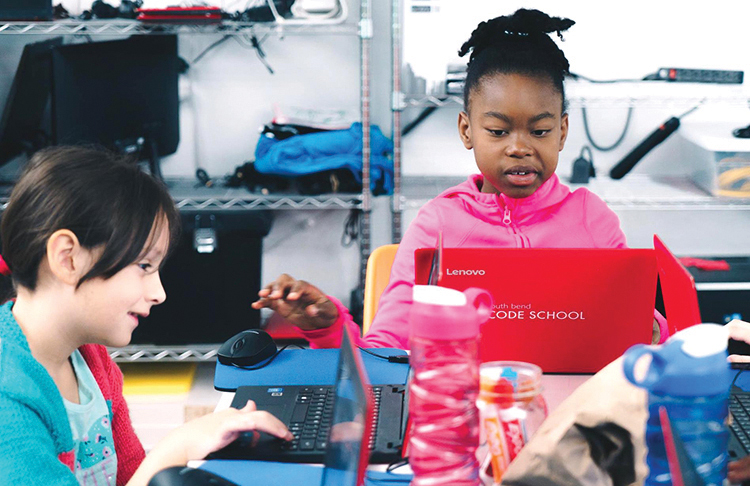South Bend Code School in Fort Wayne: Now Enrolling

Black children are coding, writing and designing beautiful computer science language. But not many. Alexandra (Alex) Sejdinaj, co-founder of the South Bend Code School (SBCS), can testify to that, can show the class pictures.
Across our 4 locations throughout the state, about 45% of our students are underrepresented minorities. “One of our goals is to reach more underrepresented minorities, and we are still learning the best ways to do this in Fort Wayne, in particular,” Sejdinaj said. “It seems like [the code school] makes a difference the longer that we are in an area.”
There were immediate results, right out the gate. In the Spring of 2015, the co-founders saw 19 students who never coded before, middle to high school age, output 23 web apps, four of those were dedicated to promote nonviolence…all were presented at a community demonstration with presidential candidate Mayor Pete Buttigieg in the attendance.
The next day, the partners took their young coders to Google Chicago, for networking, to show off their apps…for encouragement, as the Google employees spoke about the viability of their projects and expressed wonder at how young they were. The students were a mixture of kids who wanted to attend college and those that were unsure. And “they were able to have an open conversation with the Google professionals,” Sejdinaj said, “who didn’t all go to college [ or major in computer science to work there].”
There were marketing and sales people also employed there, who used their skills to pursue different career tracks that a person might not traditionally associate with a technology background. It was real-world proof to the kids “that you can find your niche but still be able to work in an innovative environment that you would enjoy.”
That first coding group set the pace for SBCS; on the docket were plans for expansion. Code School fielded 13 inquiries about future programming locally after that initial program, held at Robinson Community Learning Center. They continued to grow the program locally but also looked at taking the program to other cities throughout the state. Fort Wayne was the first expansion city. They linked up with the folks over at Start Fort Wayne, the co-working space downtown off West Berry Street; they also have locations in Elkhart and Bloomington.
About four years ago, Sejdinaj started SBCS with her then boyfriend (now husband), Alex, and friend Chris Frederick by chance through a mutual friend; all three wanted to teach children how to code. Sejdinaj, originally from Atlanta, Georgia, was pre-med at the University of Notre Dame when she discovered coding; opening up her career options, she taught herself coding. (Her husband, who had already graduated from IU Bloomington, taught himself how to code as well.)
Sejdinaj’s parents were “fairly concerned” at the guess-what-surprise move. “They were surprised about my decision to start a coding program, and they were happy to see that the program was going well,” she said. They came around when Mayor Pete tweeted positives about their code school.
SBCS now operates under a year-round rolling admission type of program. Kids can choose their own learning tracks, including but not limited to, web development, video game design, python programming, graphic design, or 2D and 3D animations. They’ve expanded their age group so now ages 7 to 18 are taught. Tuition is $150/month for a total of four classes, two hours allotted each class. Full and partial scholarships are available for all of their programs.
Sign-ups can happen anytime throughout the year; their Fort Wayne website can be found here: SBCSFortWayne.com. For their South Bend site, hit up SouthBendCodeSchool.com.
The Fort Wayne classes are held at ATRIUM: Start Fort Wayne. Sejdinaj and her partners are looking, as always, to find new ways to introduce more kids to coding.
I run Scrambled Egg(s) Design and Productions, based out of Northeast Indiana. In addition to producing in-house company projects, I also create advertising materials for companies and organizations, with an emphasis on interactivity.



